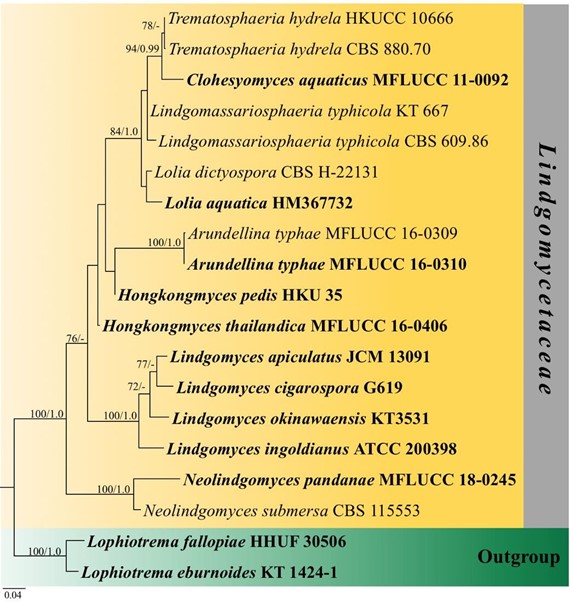Hongkongmyces C.C.C. Tsang, J.F.W. Chan, Trend.-Sm., A.H.Y. Ngan, I.W.H. Ling, S.K.P. Lau & P.C.Y. Woo, Medical Mycol. 52(7): 740 (2014).
MycoBank number: MB 805515; Index Fungorum number: IF 805515; Facesoffungi number: FoF 08269; 3 morphological species (Species Fungorum 2020), 3 species with molecular data.
Type species – Hongkongmyces pedis Tsang, Chan, Trendell-Smith, Ngan, Ling, Lau, Woo, Medical Mycol. 52(7): 740 (2014).
Notes – Hongkongmyces was reported as a pathogen of a foot nodule biopsy of a human with suppurative granulomatous in Hong Kong. Species have been collected from various countries, including Hong Kong, China (Hongkongmyces pedis, Tsang et al. 2014), Sukhothai, Thailand (Hongkongmyces thailandicus, Hyde et al. 2017) and Pennsylvania, USA (Hongkongmyces snookiorum, Crous et al. 2018c). The type species is characterized by forming grey colonies on media, composed of grey, narrow, septate, branched hyphae with acute angles, sterile mycelia with no fruiting bodies or sporulating structures (Tsang et al. 2014). Hongkongmyces snookiorum is coelomycetous with globose to ampulliform pycnidia, hyaline, subulate to ampulliform conidiogenous cells with sympodial proliferations, hyaline, ellipsoid to ovoid conidia, while H. thailandicus is ascomycetous with globose, short-papillate ascomata, cylindrical to clavate asci, and hyaline, fusiform to cylindrical ascospores with a mucilaginous sheath (Hyde et al. 2017, Crous et al. 2018c). Hyde et al. (2017) showed that H. thailandicus (collected from decaying wood) clustered with H. pedis (with moderate support), while they are not group together in our study (Fig. 97). This implies more work need to be done in this genus.

Figure 97 – Phylogram generated from maximum likelihood analysis (RAxML) of genera in Lindgomycetaceae based on ITS, LSU, and SSU sequence data. Maximum likelihood bootstrap values equal or above 70 %, Bayesian posterior probabilities equal or above 0.90 (MLBS/PP) are given at the nodes. An original isolate number is noted after the species name. The tree is rooted to Lophiotrema eburnoides (KT 1424-1) and L. fallopiae (HHUF 30506). The ex-type strains are indicated in bold. Hyphen (-) represents support values below 70 % MLBS and 0.95 PP.
Species
Hongkongmyces pedis
